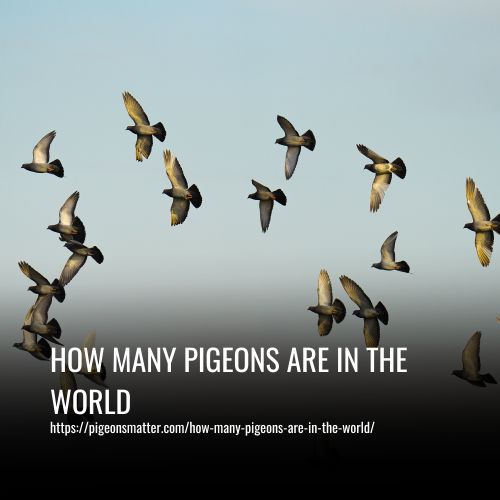The global population of pigeons is estimated to be between 400 and 600 million. These birds can be found on every continent except Antarctica, and they have a remarkable ability to adapt to different environments. Pigeons thrive in cities, towns, farmlands, and remote areas, and they are particularly well-suited to urban environments due to the abundance of food and shelter. Cities like New York, London, and Rome have large populations of feral pigeons.

Why Are Pigeons Everywhere
Feral pigeons can be found on every continent except Antarctica. They have a commensal relationship with humans, preferring to live in urban areas and benefitting from the habitat and food sources we provide. Despite our negative perception of them, it is our own actions that have caused the widespread presence of pigeons.
European colonists introduced domestic pigeons to the Americas in the 17th century, and European settlers brought them to Australia in the 1870s. Feral pigeon populations were established as these birds escaped and adapted to their new environments. While we may consider pigeons to be pests, it is important to recognize that we are responsible for their presence.
Where Did Pigeons Come From
Rock doves, also known as pigeons, have a fascinating history with humans. They were originally consumed for food by both Neanderthals and Homo sapiens. Later, humans domesticated them for their navigational skills. Pigeons have a homing instinct, allowing them to fly back to their coops even when released hundreds of miles away.
This ability has been used by humans to guide sailors and deliver messages over long distances. Messenger pigeons played a crucial role in wars, including WWI and WWII. Eventually, chickens became the preferred source of meat, and pigeon breeding became a popular hobby. Charles Darwin studied and bred domestic pigeons, which contributed to his understanding of evolution.
Factors Influencing Pigeon Population
Pigeon population growth and distribution are influenced by a variety of factors, including food availability, predation and diseases, and human intervention.
1. Food Availability
Pigeons primarily feed on seeds and grains, but they are opportunistic eaters and will consume fruits, vegetables, and human food waste. In urban environments, unintentional feeding by humans contributes to their population growth.
2. Predation and Diseases
Pigeons face predation from birds of prey like hawks and falcons. They are also susceptible to diseases caused by viruses, bacteria, and parasites. Diseases such as avian influenza and Newcastle disease can have a significant impact on pigeon populations.
3. Human Intervention
Urbanization and human activities have had a major impact on pigeon populations. The construction of buildings provides pigeons with nesting sites, similar to the cliff dwellings of their ancestors. However, efforts to control pigeon populations through trapping, poisoning, or habitat modification can cause local declines.
Understanding these factors is important for predicting pigeon population trends and managing coexistence with these birds in urban ecosystems.
Pigeon Population In Urban Areas
Urban environments provide pigeons with ample food sources and roosting/nesting opportunities, making cities an ideal habitat for them. Major cities like New York City, London, and Paris have large pigeon populations, with estimates ranging from hundreds of thousands to millions of pigeons.
While pigeons contribute to nutrient cycling and serve as prey for urban predators, they can also cause damage to buildings and monuments with their droppings. Pigeons can potentially spread diseases to humans, although the risk is low.
Their noise, droppings, and occasional aggressive behavior can also be a nuisance. Finding a balance in managing our relationship with these urban pigeons is crucial.
Different Types of Pigeons
Pigeons are a diverse family of birds that can be found in many habitats across the globe. There are several distinct species, including the feral pigeon, rock dove, and wild pigeon. Feral pigeons are descended from domesticated pigeons and live in cities, often nesting on window ledges or rooftops. Rock doves are wild cousins of domestic pigeons and inhabit rocky cliffs.
Wild pigeons live in forests and woodlands where they feed on grains, fruits, vegetables, insects, and food waste. Homing pigeons have been selectively bred to return home even when released hundreds of miles away from their roosts. Urban pigeons are also commonly seen living in cities and scavenging for food sources such as scraps thrown by humans.
Common pigeons can be found in both rural and urban areas with domesticated populations living in dovecotes or flimsy nests on rooftops while wild birds nest in trees or crevices of cliffs and buildings.
Despite the diversity of pigeon species, all members of the Columbidae family face threats from predators such as hawks as well as humans hunting them for sport or food. As their habitats become increasingly threatened by urbanization it is important to take steps to protect these beloved birds so their numbers can continue to thrive for generations to come.
Pigeons Estimation Methodologies
Estimating the total number of pigeons in the world is a complex task that requires the use of various methods. These methods include direct counting, mark and recapture, statistical models, and technological methods.
1. Direct Counting
Direct counting involves physically counting pigeons in specific areas. While this method can provide accurate results in small areas with high visibility, it becomes impractical and less accurate for larger areas or dense populations.
2. Mark And Recapture
Mark and recapture techniques involve marking a sample of pigeons, releasing them back into the population, and then recapturing a new sample to estimate the total population size. This technique can provide good population estimates, but it may be challenging due to the difficulty of marking and recapturing pigeons.
3. Statistical Models
Statistical models are used to estimate pigeon populations based on sampled data. These models can incorporate various factors that affect population size, but their accuracy heavily relies on the quality of the sampled data and the assumptions made in the model.
4. Technological Methods
Technological methods, such as satellite imagery and acoustic monitoring, can cover large areas and inaccessible terrains. However, they often require specialized equipment and substantial resources. Additionally, these methods may have limitations in distinguishing between similar species.
Given the challenges and limitations of each method, estimating the total number of pigeons in the world is a difficult task. It requires researchers to use a combination of these methods and carefully consider the strengths and limitations of each to arrive at the most accurate estimate possible.
Pigeon Population Control Efforts
It is important to manage pigeon populations because they can become a nuisance in urban areas. Overpopulation can lead to droppings that contaminate streets, gardens, and public spaces. Pigeons can also interfere with infrastructure such as power lines and buildings.
To control pigeon numbers, cities have implemented various methods including nest removal, birth control programs using contraceptives, trapping and relocation, and even euthanasia. Although these methods can be effective, it is important to ensure that animal welfare is taken into consideration.
How Long Do Pigeons Live
In the wild, pigeons have an average lifespan of 3 to 5 years. However, when kept in captivity, pigeons can live up to 15 years. It’s important to note that these are general lifespan estimates, and individual pigeons may vary in their lifespan based on various factors such as predation, disease, and habitat conditions.
FAQs
Yes, pigeons mate for life. They are known to be monogamous and form strong pair bonds. Once they find a mate, they will stay together and continue to mate for the rest of their lives.
Feral pigeons, which are the ones commonly found in urban areas, are not considered threatened or endangered. However, certain wild pigeon species may be facing threats due to habitat loss.
While it is difficult to determine the exact population, it is estimated that there are approximately one million pigeons in New York City.
Different factors contribute to the varying estimates of the global pigeon population. These factors include the different methods used to count the pigeons, the timing of the count, the local conditions in different areas, and even how individuals define what qualifies as a “pigeon.”
Pigeons have both positive and negative impacts on the urban environment. They can help with nutrient cycling and serve as a food source for urban predators. However, their droppings can damage buildings and monuments, and they can potentially transmit diseases to humans.
Conclusion
While we may never know exactly how many pigeons are in the world, one thing is for sure: they are a ubiquitous and fascinating part of our urban landscape. Whether you love them or hate them, there’s no denying the important role they play in our ecosystem and our cultural imagination.
So the next time you spot a flock of pigeons, take a moment to appreciate these feathered friends and all that they represent.


